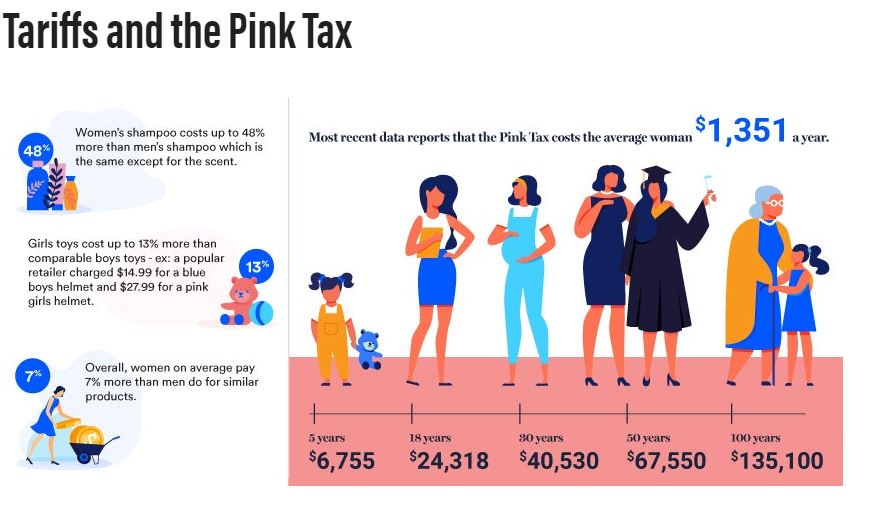
FINANCIAL EXPLOITATION - We were approached by a US organisation that wants to highlight the issue of explotation and discrimination by retailers, manufacturers finance and credit card companies.
The Pink Tax: How Women Pay More for Pink.
It is a poorly kept secret that retail campaigns often target female consumers due to the antiquated idea that women like to shop and spend more money than men. Perhaps a better-kept secret in consumer sales, however, is not that women face more targeted advertising, but that items women buy often cost more than identical or very similar “men’s” products.
Gender-specific pricing (where items for women cost more than items for men) is often referred to as the “Pink Tax.” Despite its name, the Pink Tax is not a tax but rather a system of discriminatory pricing that can cost the average woman more than $1,300 a year.
To firmly entrench female consumers in their gender-normative sales practices, manufacturers often use bright pink or purple packaging, and sweet scents like peony, vanilla and even “fruity bubble in paradise” to make sure women know the product is just for them.
The Pink Tax doesn’t only affect adult women. A study from the New York City Department of Consumer Affairs found that young girls cannot escape the pitfalls of the Pink Tax because “girl toys” cost on average 2 percent to 13 percent more than “boy toys” that are the same other than their color.
This speaks to one of the fundamental problems with the Pink Tax: it’s not always simple to identify.
Sure, you notice when your razor or shaving cream costs more than men’s products, but what about shirts? Pants? How can you tell if you are paying more for products that don’t have an easy comparison point? Merchants, brands and product quality vary, making it hard to determine a fair price without gender bias.
The most accurate product comparisons consider merchandise of similar quality from the same manufacturer — and in these comparisons, gender bias is prevalent among many top clothing stores. For example, the average cost of a woman’s pair of jeans at one popular retailer is $62.75 while comparable men’s jeans at the same store cost $57.09 —a 10 percent price increase for women.
The scope of Pink Tax pricing
The Pink Tax doesn’t only affect adult women. A study from the New York City Department of Consumer Affairs found that young girls cannot escape the pitfalls of the Pink Tax because “girl toys” cost on average 2 percent to 13 percent more than “boy toys” that are the same other than their color.
This speaks to one of the fundamental problems with the Pink Tax: it’s not always simple to identify.
Sure, you notice when your razor or shaving cream costs more than men’s products, but what about shirts? Pants? How can you tell if you are paying more for products that don’t have an easy comparison point? Merchants, brands and product quality vary, making it hard to determine a fair price without gender bias.
The most accurate product comparisons consider merchandise of similar quality from the same manufacturer — and in these comparisons, gender bias is prevalent among many top clothing stores. For example, the average cost of a woman’s pair of jeans at one popular retailer is $62.75 while comparable men’s jeans at the same store cost $57.09 —a 10 percent price increase for women.
A lesser-known influence on gender-based pricing is the cost of tariffs on retail items. Tariffs are taxes that are imposed by the federal government on products imported to the United States. Consumers in the United States pay for the cost of these tariffs because retailers raise the cost of their merchandise to offset import taxes. Some products that are seemingly gender neutral — like cotton shirts and leather boots — have female versions that are subject to higher tariffs than comparable male items. On the other hand, some items (such as men’s bathing suits) are subject to higher tariffs than women’s bathing suits.
The influence of tariffs on retail pricing makes it difficult to solely blame manufacturers for gender-based pricing discrepancies seen in stores across the nation. Tariffs do not, however, fully explain or justify the existence of the Pink Tax because discriminatory pricing based on gender is prevalent not just in the case of retail merchandise but also in everyday services.
Pink Tax on services
Women don’t face added costs on products alone. Many services such as dry cleaning and auto maintenance could cost you more if you are a woman.
CBS News conducted an experiment where two members of their staff — a man and a woman — went to multiple dry cleaners in New York City with the same white cotton button-up shirt. “More than half of the dry cleaners charged the female staff member at least twice as much to clean the shirt. Some even charged her three times as much.”
Research has found that pricing for car repairs also has its own version of the Pink Tax.
A study by the National Bureau of Economic Research had male and female participants call mechanics to get quotes for car repairs. Callers who appear to be well-informed about pricing were treated the same regardless of gender. However, female callers who were uninformed on pricing were quoted almost $23 more on average than male callers.
Algorithms in the credit card industry
Complaints of potential gender bias in credit card approvals went viral in 2019 when entrepreneur David Hansson publicly accused Apple and Goldman Sachs of gender discrimination after his wife’s application for an increased credit line was denied. Hannson pointed out that his credit line was 20 times higher than his wife’s, even though they share finances and she had a better credit score.
In response to the backlash, Apple and Goldman Sachs emphatically denied any deliberate bias and instead blamed their algorithm, which determines a potential credit card owner’s creditworthiness.
It’s difficult to prove an algorithm has a bias, because it considers so many factors, but we do know debt-to-income ratio is a primary factor in credit approval, which may impact bias.
In the United States, women make on average make 79 cents for every dollar that a man makes — and that’s just white women. Women of color and Hispanic women make roughly 74 cents for every dollar a man makes.
How to stop paying for pink
So, if there isn’t a credit card that can fully offset the cost of the Pink Tax, how can women avoid paying more for pink?
Unfortunately, there’s no easy solution to the Pink Tax problem.
You can save money by shopping for gender-neutral products or those targeted toward men. This solution won’t work for everyone, but it can help you avoid overpriced “female” products like shampoos and shaving creams.
If smelling like Old Spice “Swagger” isn’t your thing, however, then the journey to paying less for pink might prove to be an uphill battle.
If you see something, say something!
Whether it be razors, shaving cream, jeans, children’s toys, or even laxatives, making items cost more just because they are targeted towards women is discrimination. The only true way to end the Pink Tax is to call out brands that perpetuate a system of discriminatory gender-based pricing.
Your voice can make a difference. In November of 2019, the Ohio House of Representatives passed a bill that aimed to eliminate the Pink Tax by removing luxury taxes on feminine hygiene products in the state and ending gender-based pricing.
You too can help eliminate the Pink Tax once and for all say campaigners by contacting your Member of Parliament or Trading Standards (in the UK) and your local representative in the USA and speaking out against discriminatory pricing.
ABC Comment: Thanks to Bankrate, Inc.100 5th Ave.,16th Floor | New York, NY 10011 for bringing this to our attention.
ABC Comment have your say below:

Leave a comment
Make sure you enter all the required information, indicated by an asterisk (*). HTML code is not allowed.
Join
FREE
Here











